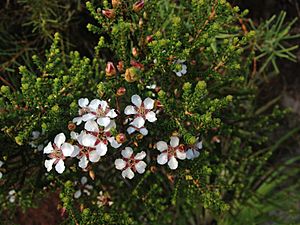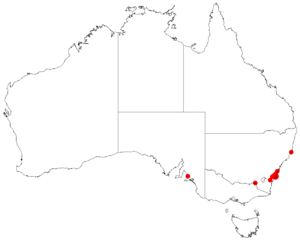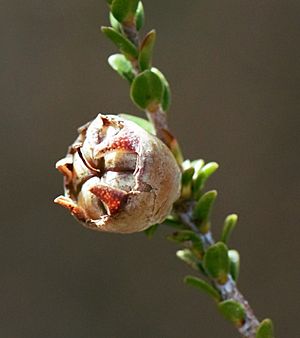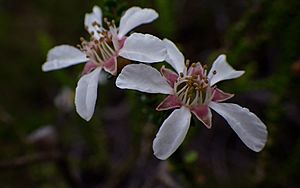Leptospermum epacridoideum facts for kids
Quick facts for kids Leptospermum epacridoideum |
|
|---|---|
 |
|
| Scientific classification | |
| Genus: |
Leptospermum
|
| Species: |
epacridoideum
|
 |
|
| Occurrence data from AVH | |
| Synonyms | |
|
Leptospermum epacridioideum Cheel orth. var. |
|
Leptospermum epacridoideum is a special kind of plant. It is a bushy shrub that only grows in a small area. This area is on the South Coast of New South Wales, Australia. It has rough bark and small, round leaves. This plant also has pretty white flowers. These flowers grow alone on short side branches. After flowering, it produces woody fruits.
What Does It Look Like?
Leptospermum epacridoideum is a bushy shrub. It usually grows to be about 1 to 2 meters (3 to 6 feet) tall. Its younger stems are thick. They are also covered with tiny, soft hairs.
The leaves of this plant are broadly oval or almost round. They are about 2 to 3 millimeters long. They are also about 2 millimeters wide. The leaves grow on a short, thick stem called a petiole.
The flowers are usually white. Sometimes, they can be a light pink color. Each flower grows by itself on a short side branch. They are about 6 to 10 millimeters wide. The base of the flower has reddish-brown leaf-like parts. These are called bracts and bracteoles.
The cup-shaped part of the flower is smooth. It is about 3 millimeters long. The sepals are long and triangular. They are about 3.5 millimeters long and have soft hairs. The petals are about 5 millimeters long. The stamens, which are the parts that make pollen, are grouped together. There are usually five to seven stamens in each group. They are about 2.5 millimeters long.
This plant mainly flowers from February to March. The fruit is a woody capsule. It is about 6 to 8 millimeters long. This fruit grows directly on the stem without a stalk. Over time, the fruit falls off the plant.
Naming the Plant
The plant Leptospermum epacridoideum was officially named in 1919. It was named by a person called Edwin Cheel. He wrote about it in a science journal. The journal was called the Journal and Proceedings of the Royal Society of New South Wales. When he first named it, he spelled it a little differently. He originally called it Leptospermum epacridioideum.
Where Does It Grow?
This type of tea-tree grows in forests. It also grows in open, shrubby areas called heathland. It prefers to grow on sandstone soil. You can find it in the area around Jervis Bay.



